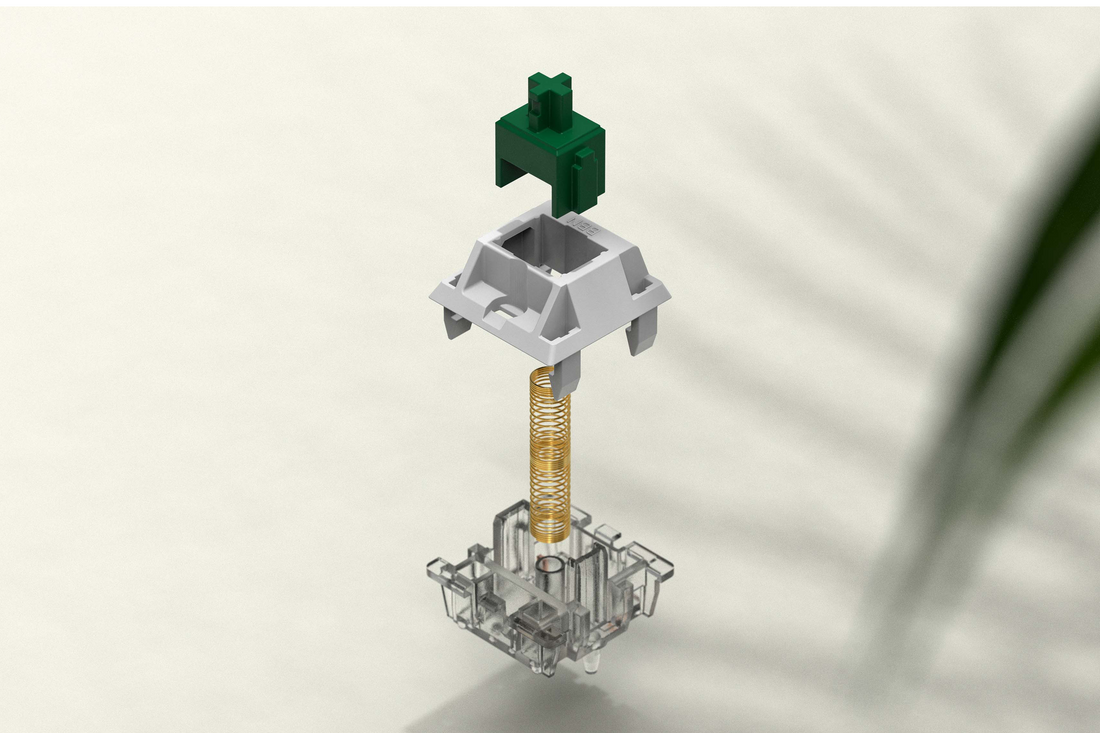
A Short Talk About Long Stem Poles
Share
Linear switches are without question the most consistently mocked of the three big types of mechanical keyboard switches. Jokes about their simplicity, “all feeling the same”, and price per performance are all constantly brought up as talking points in a very one sided (and misguided) set of opinions. Given that I am the one person who would care to defend any and all switches, I would instead argue that there are plenty of niche designs within linear switches that not only make or break their performance, but are features which can really bring a unique feeling to a switch. One of these more notable features to gain popularity with some people over the past few years while completely flying under others’ radars is that of long stem poles. But what are “long” stem poles? Do they really change the feeling of my switches that much?

Figure 1: Generic mechanical keyboard switch stem with slider rails and stem pole labeled.
To cut this down to the most simple of explanations for those not familiar with switch components, “stem poles” refer to the long and skinny portion of the stem as shown in the image above. When placed inside of a closed switch, this pole sits inside of a small hole in the bottom housing of the switch and traditionally acts only as a sort of guide rail for the stem to move up and down when typing. While the stem pole helps keep the stems perfectly aligned in this hypothetical traditional switch, the slider rails also do such while also acting as the collision point between the stem and bottom housing when a switch is pushed all the way in. This is the collision that gives that firm, solid end to a keystroke. However, if the length of the stem pole is increased, the roles can reverse between these two parts causing the pole to contact the bottom housing instead of the slider rails. As you could imagined, this can cause a myriad of different effects with respect to how switches both sound and feel.
Aside just changing which part of the stem bottoms out first, switches with long stem have fundamentally different feelings and sounds as a result of this change. If we think of a nearly comically long stem pole inside of a switch as an example, this would greatly shrink the available space for the stem to move up and down in normal operation. This, in turn, would cause the total stem travel distance to shrink from a standard 4.00 mm in distance to 3.50 mm and even shorter in some cases. Not only does this reduce the total travel distance of the stem within the switch, but this can also change where the activation point of the switch is relative to the bottom out – with shorter travel distances making the actuation point seem much more centered in the downstroke. As for bottoming out, switches which feature long stem poles often have a much more sharpened and pointy feeling bottom out which accentuates the feelings and sounds associated with the material of the bottom housing. For example, polycarbonate bottom housings which have a reputation for feeling thinner and more plasticky feel even more thin when contacted by a long stem pole – something which also increases the volume and pitch of most bottom outs too!

If long stem poles are starting to sound a bit more intriguing to you after the last paragraph, and they absolutely better for the sake of the rest of this article, then it would be extra useful for you to know about what actually constitutes a long stem pole and where to find some. While there are no hard and fast rules in the community regarding what is and isn’t technically “long”, the arbitrary line I draw in the sand is a total top to bottom stem height of 13.50 mm. Anything beyond this total length acts a long stem pole and anything smaller is just a normal stem. For perspective, of the 175 linear switches that I’ve measured as of the time of writing this article, only 35 had a total stem length at or beyond 13.50 mm, with less than a third of those going beyond 13.60 mm. As to be expected, all of these linear switches also had total stem travel distances below 4.00 mm in total length in their stock form.*

Figure 3: Long Pole switches including Aflion Blush, Tecsee Ruby, KTT Lightning, and TTC x Varmilo Speed Gold.
Of the 35 linear switches that I have measured and can definitively tell you fit my arbitrary criterion for being ‘long pole’, many people in the community more familiar with switches would immediately assume the list was topped by Zakus and filled almost entirely with Tecsee-made switches. While both Zakus and Tecsee have been a jumping off point for a ton of people to explore long pole stems, many people would be shocked to find that Aflion actually has a higher average stem length of 13.57 mm across the 14 switches I measured as compared to Tecsee at 13.32 mm across 33 switches. Further shocking is that of that list of 35, Zakus actually rank 21st in terms of total stem length, with switches such as Akko Crystal Silver, KTT Lightning, and TTC x Varmilo Speed Gold topping the list at 14.02, 13.99, and 13.97 mm in total stem length! Switches that Dangkeebs specifically stocks on this list also include Aflion Blush, Tecsee Ruby, and their very own Strawberry Milk Linears.
And with that, you should officially be armed with the knowledge and direction needed to go exploring for your new favorite long pole switches. Being far from a comprehensive guide, it’s really worth stressing here that you should be buying and testing switches for yourself before making full keyboard purchasing decisions based on one single goat’s article. The degree to which a bottoming out is changed, sharpened, and pitch shifted is very different from switch to switch is a lot more nuanced than something as simple as a few measurements. To make this all just a tiny bit more interesting for you on the way out – it’s also worth mentioning that there are long pole tactile switches too…
*Note: One thing that was not mentioned in the article above which is incredibly important to note is that frankenswitching long pole stems from switch A into the bottom housing of switch B may not reduce travel distance. Because of the fact that long stem poles only bottom out before the slider rails in the switches they were designed to be in, mixing into housings of different measurements will yield different results. Your mileage (or in this case millimeters) will vary.

